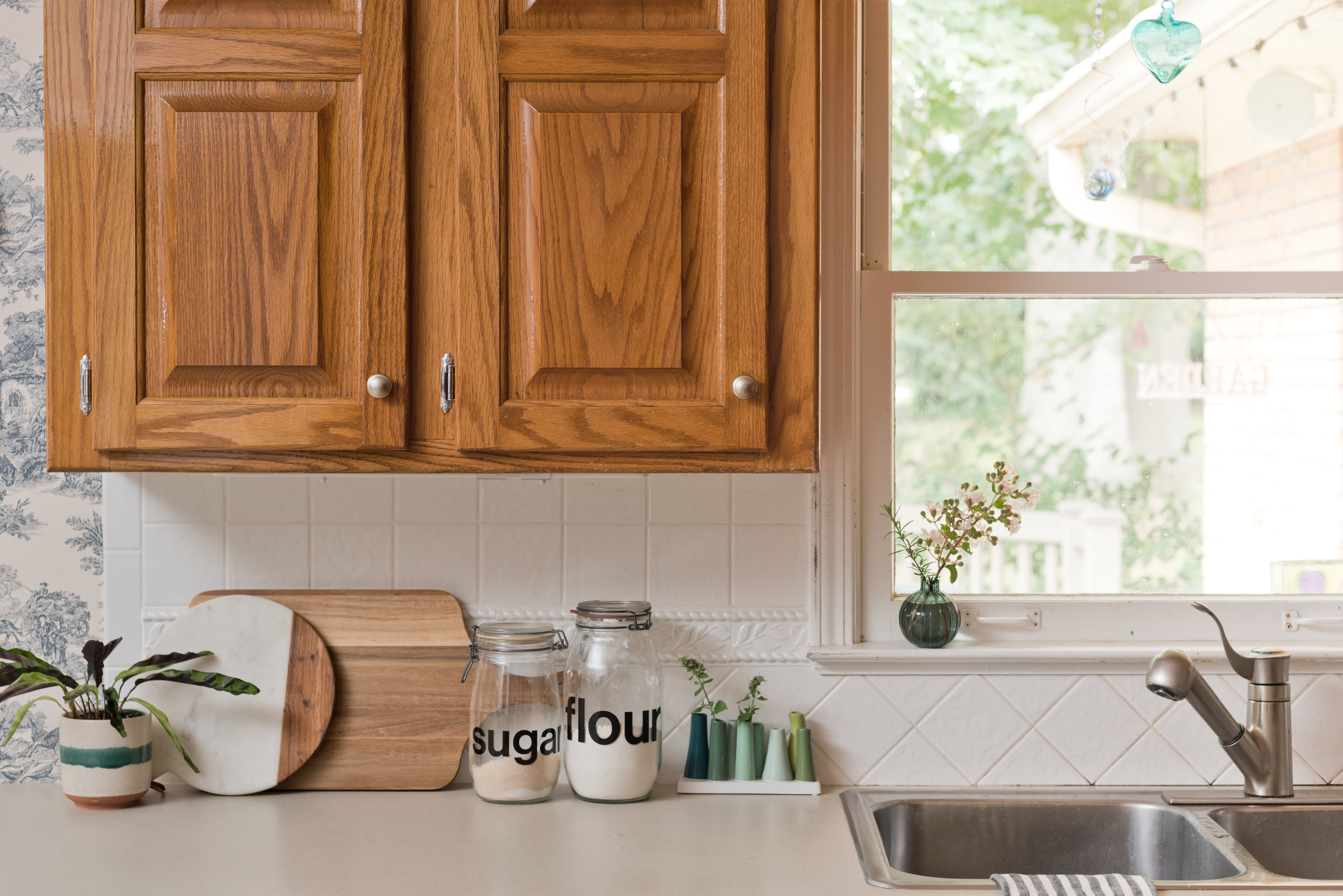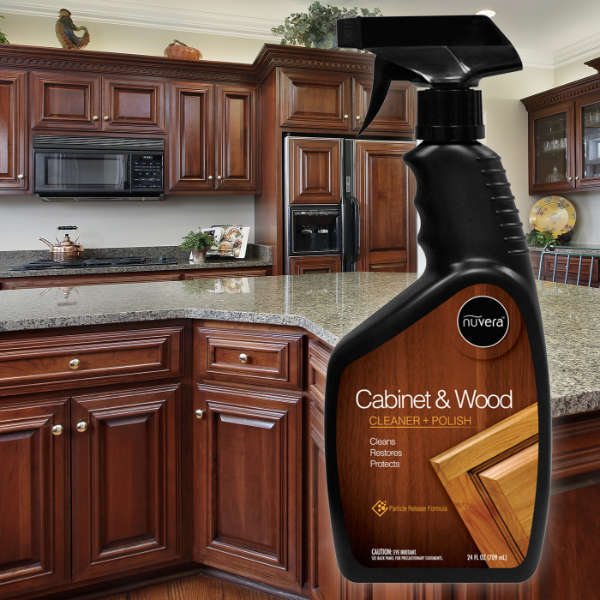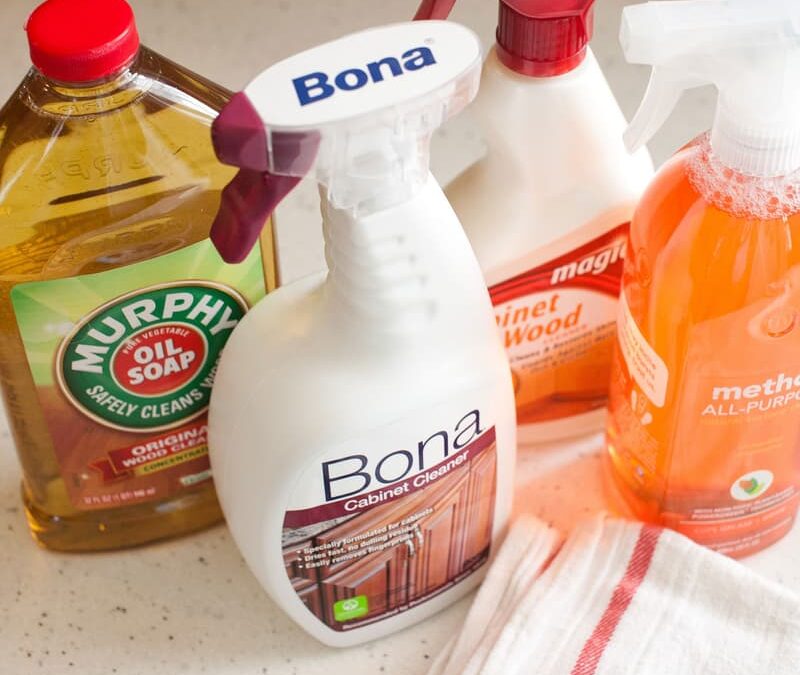Are your kitchen cabinets looking a bit dull and lifeless? You might be wondering what the best wood cleaner for kitchen cabinets is to restore their shine and beauty.
Choosing the right cleaner is not just about making your cabinets look good—it’s about preserving their quality and extending their life. But with so many options out there, how do you know which one to pick? Imagine transforming your kitchen space with ease, leaving it spotless and vibrant.
Keep reading, and you’ll discover the secret to achieving spotless, gleaming cabinets that will make you love your kitchen all over again. Whether your cabinets are coated in layers of grease or just need a gentle refresh, we’ve got the insights you need. Let’s dive into the best options to make your kitchen the heart of your home once more.

Credit: www.thekitchn.com
Importance Of Wood Cleaners
Choosing the best wood cleaner for kitchen cabinets keeps them looking fresh and extends their lifespan. Effective cleaners remove grime, grease, and stains without harming the wood. Proper care ensures cabinets maintain their shine and functionality.
Cleaning your kitchen cabinets might not be the most exciting chore, but it’s crucial for maintaining their beauty and longevity. Wood cabinets add warmth and character to your kitchen, and using the right cleaner can make all the difference in preserving that charm. Neglecting proper care can lead to damage, dullness, and even warping. But, what’s the best way to keep them looking pristine?Why Wood Cabinets Need Special Care
Wood is a natural material that reacts to its environment. Grease, steam, and food spills are common in kitchens, and they can wreak havoc on your cabinets. Using a specialized wood cleaner ensures that your cabinets are not only clean but also nourished. Ordinary cleaners might strip away the protective finish, leaving the wood vulnerable.Choosing The Right Cleaner
Not all wood cleaners are created equal. Look for products that are specifically designed for kitchen cabinets. They should be gentle yet effective, removing grime without damaging the finish. I once used a multi-purpose cleaner on my cabinets, only to find them looking dull and lifeless afterward. It was a hard lesson in choosing the right product.Eco-friendly Options
Many people are becoming more conscious about the products they use. Eco-friendly wood cleaners can be a great option if you’re looking to reduce your environmental footprint. These cleaners often use natural ingredients that are less harmful to both your cabinets and the planet. Have you considered how your choice of cleaner impacts the environment?Regular Maintenance
Cleaning your cabinets isn’t a one-time task. Regular maintenance is key to keeping them in top condition. Make it a habit to wipe down your cabinets weekly to prevent buildup of grease and grime. This simple routine can save you from bigger cleaning tasks down the road.Test Before You Commit
Before you fully commit to a wood cleaner, test it on a small, inconspicuous area of your cabinets. This ensures that the cleaner doesn’t cause discoloration or damage. I learned this the hard way when I tried a new cleaner on an entire cabinet door, only to find that it left a sticky residue. Choosing the right wood cleaner for your kitchen cabinets can seem daunting, but it’s worth the effort. Consider factors like the composition of the cleaner, its impact on the environment, and your routine maintenance needs. What steps will you take today to ensure your cabinets remain a beautiful centerpiece in your kitchen for years to come?Types Of Wood Cleaners
Choosing the right wood cleaner for your kitchen cabinets is vital. It helps maintain their beauty and longevity. Various types of wood cleaners are available. Each type offers unique benefits and suitability. This section explores different types of wood cleaners. Learn which might work best for your kitchen cabinets.
Oil-based Cleaners
Oil-based cleaners are ideal for deep cleaning. They nourish the wood and add shine. These cleaners penetrate the surface and remove grime. They are excellent for older cabinets. Oil-based cleaners enhance natural wood color. They can make your cabinets look refreshed.
Water-based Cleaners
Water-based cleaners are gentle on wood surfaces. They are easy to use and quick to dry. These cleaners are less likely to leave residue. They are suitable for routine cleaning tasks. Water-based cleaners are often non-toxic. They are a safe choice for families with children.
Natural And Eco-friendly Options
Natural and eco-friendly cleaners use plant-based ingredients. They avoid harsh chemicals, making them safe for the environment. These cleaners are great for health-conscious households. They provide effective cleaning without harmful effects. Natural options can include vinegar or lemon oil solutions. They are both efficient and sustainable choices.
Factors To Consider
Choosing the best wood cleaner for kitchen cabinets requires careful thought. Different factors can affect the choice of cleaner. It’s not just about cleaning power. Consider how the cleaner interacts with cabinet material. Think about ease of application and the ingredients used. Each factor plays a crucial role in maintaining your cabinets.
Cabinet Material Compatibility
Wood type matters in selecting a cleaner. Not all cleaners suit every wood finish. Oak, maple, and cherry each have unique needs. Ensure the cleaner matches the cabinet’s material. Compatibility prevents damage and preserves the wood’s beauty.
Ease Of Use
Look for a cleaner that’s easy to apply. Spray bottles offer convenience. Wipes can be handy for quick touch-ups. Consider the time required for cleaning. Simple application methods make maintenance easy and stress-free.
Safety And Ingredients
Check the cleaner’s ingredients for safety. Avoid harsh chemicals that can harm wood. Natural ingredients are often safer. They reduce the risk of damage. Ensure the cleaner is safe for children and pets. This ensures a healthy kitchen environment.
Top Picks For Wood Cleaners
Choosing the best wood cleaner for kitchen cabinets ensures longevity and shine. Opt for gentle formulas that remove grease without damaging the finish. Look for cleaners with natural ingredients to maintain the beauty of your wooden cabinets effectively.
Choosing the best wood cleaner for kitchen cabinets can be tricky. Many products claim to clean, but only a few stand out. This section highlights top picks that ensure your cabinets shine. Each option caters to specific needs and budgets.Best For Deep Cleaning
For a thorough cleanse, Murphy’s Oil Soap takes the lead. It penetrates grime and removes stubborn stains. The formula is gentle, preserving wood’s natural finish. It’s perfect for those who need a powerful cleaner without harsh chemicals. Regular use keeps cabinets looking new.Best Eco-friendly Option
Concerned about the environment? Method Wood For Good is your answer. This plant-based cleaner is free from toxic elements. It leaves a fresh almond scent, enhancing your kitchen’s ambiance. Safe for you and the planet, it cleans effectively. Ideal for homes with kids and pets.Best Budget-friendly Choice
Pledge Multi-Surface Cleaner offers great value. It cleans wood and other surfaces efficiently. This makes it versatile for various kitchen needs. Affordable yet effective, it leaves cabinets spotless. It’s perfect for those seeking quality on a budget.How To Apply Wood Cleaners
Choosing the right wood cleaner for kitchen cabinets ensures lasting shine and protection. Apply gently with a soft cloth, following the grain to avoid scratches. Popular choices include oil-based cleaners for natural wood and mild detergents for painted finishes.
Maintaining the pristine look of your kitchen cabinets can sometimes feel like a daunting task, especially if they’re made of wood. Choosing the best wood cleaner is just the first step. Knowing how to apply it effectively ensures your cabinets remain both beautiful and durable. Let’s dive into the essential steps to make your cleaning routine easy and efficient.Preparation Steps
Before you start, gather all necessary materials. You’ll need a soft cloth, your chosen wood cleaner, and a small bucket of warm water. Make sure the area is well-ventilated to avoid inhaling fumes. Empty your cabinets. This prevents any cleaning solution from damaging your stored items. Also, it’s a good opportunity to declutter and reorganize. Wipe off any loose dust or debris with a dry cloth. This prepares the surface for a thorough clean without spreading dirt around.Application Techniques
Begin by dampening your cloth with the wood cleaner. Avoid soaking it, as too much liquid can damage wood. Gently rub the cloth on the cabinet surfaces in a circular motion. This helps the cleaner penetrate and lift grime without scratching the wood. For stubborn spots, apply a bit more pressure or use a toothbrush for precision cleaning. Always test a small, hidden area first to ensure no discoloration occurs.Post-cleaning Care
Once cleaned, wipe the cabinets with a dry cloth to remove any residue. This prevents streaks and keeps your cabinets shiny. Consider applying a wood polish to enhance the natural luster and provide an extra layer of protection. This can make future cleaning even easier. Reflect on how frequently you should clean your cabinets. Regular maintenance prevents build-up and prolongs the life of the wood. How often do you think is ideal for your kitchen’s needs? Cleaning your kitchen cabinets doesn’t have to be a chore. With the right approach, you can keep them looking their best with minimal effort. Remember, a little care goes a long way!
Credit: www.nuveraproducts.com
Diy Wood Cleaner Solutions
Maintaining the beauty of kitchen cabinets can be simple with DIY wood cleaner solutions. These homemade cleaners can be as effective as store-bought products. They often use ingredients already in your pantry. They save money and reduce exposure to harsh chemicals. Let’s explore some easy recipes and their benefits and drawbacks.
Simple Recipes
One popular DIY wood cleaner uses vinegar and olive oil. Mix one cup of vinegar with one cup of water. Add a tablespoon of olive oil. Shake well before using. Apply with a soft cloth. Another easy recipe involves lemon juice. Mix two tablespoons of lemon juice with a cup of water. Add a tablespoon of baking soda. Stir until the baking soda dissolves. This solution works well for greasy surfaces.
Pros And Cons
DIY wood cleaners are cost-effective. They often use natural ingredients. This means fewer chemicals in your home. They are also easy to make. Most recipes take less than five minutes. But there are some downsides. Vinegar can have a strong smell. It may linger for a while. Some solutions might not be as strong as commercial cleaners. They might require more effort for tough stains. Always test on a small area first. Ensure the mixture doesn’t damage the wood finish.
Common Mistakes To Avoid
Choosing the right wood cleaner is crucial for kitchen cabinets. Avoid using harsh chemicals that can damage finishes. Opt for gentle, non-abrasive cleaners that maintain the wood’s natural shine and longevity.
Cleaning your kitchen cabinets can be a straightforward task, but many unknowingly make mistakes that could damage them. Have you ever wondered if you’re cleaning them correctly? Understanding common pitfalls can save you time, money, and keep your cabinets looking their best.Using Harsh Chemicals
Many people reach for strong cleaners thinking they’ll work faster. Unfortunately, these can strip the finish or discolor the wood. Try using gentle, natural cleaners or a mixture of mild soap and water instead. Always test a small area first to ensure it doesn’t harm your cabinets.Ignoring Manufacturer Instructions
Each type of wood or finish may have specific cleaning requirements. Do you remember the last time you checked the care instructions for your cabinets? Following these guidelines can prevent unnecessary wear and tear. If you can’t find the manual, a quick online search can provide the needed details.Over-saturating With Water
Excess water can warp or damage the wood. It’s easy to think that more water equals a better clean, but it can actually cause more harm. Aim for a damp cloth rather than a soaking wet one. This simple change can make a big difference in maintaining your cabinet’s integrity.Skipping Regular Cleaning
When was the last time you cleaned your cabinets? Dust and grime build-up can become hard to remove if left too long. Regular cleaning, even just a quick wipe down, can prevent stubborn stains and keep your kitchen looking fresh.Neglecting To Dry Properly
After cleaning, ensure your cabinets are thoroughly dried. Leaving moisture can lead to mold or damage. Take a few extra minutes to dry them with a clean cloth. This step is crucial to maintain your wood’s longevity.Using Abrasive Tools
Scrub brushes or rough sponges can scratch or dull the wood surface. Have you ever used a scouring pad on your cabinets? Switch to a soft cloth or sponge to avoid unintended damage. Gentle tools will clean effectively without harming the finish. Avoiding these common mistakes can lead to better results and longer-lasting cabinets. Think about your cleaning habits — are there adjustments you can make? Small changes can have a big impact, keeping your kitchen cabinets looking pristine for years to come.
Credit: kloterfarms.com
Expert Tips For Maintaining Cabinets
Maintaining kitchen cabinets keeps them looking fresh and new. They face daily wear from grease, spills, and fingerprints. Regular cleaning prevents buildup and damage. Choosing the right cleaner helps. But it’s not just about cleaning. Proper maintenance extends the life of your cabinets.
Before diving into products, consider these expert tips. They ensure your cabinets stay in top condition. With the right care, your kitchen can shine.
Regular Dusting Is Essential
Dust settles on cabinets, dulling their shine. Use a soft cloth to remove dust weekly. This simple step maintains the cabinet’s finish and color. It also prevents scratching the surface.
Avoid Excessive Moisture
Water can harm wood cabinets. Wipe spills immediately to prevent warping. Use a damp cloth for cleaning, but never soaking wet. Dry the surface after cleaning to avoid moisture damage.
Choose The Right Cleaner
Not all cleaners suit wood cabinets. Avoid harsh chemicals that strip natural oils. Opt for cleaners designed for wood surfaces. These maintain the finish without causing harm.
Test In An Inconspicuous Area
Before using a new cleaner, test it. Apply in a hidden spot first. This ensures no discoloration or damage occurs. It’s a crucial step many overlook.
Polish To Maintain Luster
Polishing enhances wood cabinets’ natural beauty. Use a wood polish occasionally. It adds a protective layer and keeps them shiny. Be sure to follow the product instructions for best results.
Inspect Hardware Regularly
Handles and hinges also need attention. Check them for wear and tear. Tighten any loose screws to avoid cabinet damage. Clean hardware with a mild solution to remove grease.
Frequently Asked Questions
How Do I Clean Wood Kitchen Cabinets?
To clean wood kitchen cabinets, use a mild soap and water solution. Apply with a soft cloth, wiping gently to remove grime. Avoid harsh chemicals or abrasive pads that can damage the finish. Dry thoroughly to prevent moisture damage. Regular cleaning preserves the wood’s natural beauty and longevity.
What Are The Benefits Of Wood Cleaners?
Wood cleaners remove dirt, grease, and stains effectively. They restore the wood’s natural shine and maintain its appearance. These cleaners often contain conditioning agents that nourish the wood, preventing drying or cracking. Regular use keeps cabinets looking fresh and extends their lifespan significantly.
Can I Use Vinegar On Wood Cabinets?
Vinegar is a natural cleaner, but use it cautiously on wood cabinets. It can dull the finish if used undiluted. Mix vinegar with water for a safer solution. Test on a hidden area first. It effectively removes grease and odors without harsh chemicals, but always dry thoroughly after cleaning.
Are Homemade Cleaners Safe For Wood Cabinets?
Homemade cleaners can be safe if used correctly. Common ingredients include vinegar, baking soda, and mild dish soap. These are gentle yet effective at cleaning wood. Always test on a small area first. Ensure your mixture doesn’t leave residue or damage the finish.
Homemade options are eco-friendly and cost-effective.
Conclusion
Choosing the right wood cleaner matters for your kitchen cabinets. Clean cabinets add beauty and extend their life. Always read labels for safe use. Natural options are gentle and eco-friendly. Test cleaners on a small area first. This avoids damage or discoloration.
Regular cleaning keeps cabinets fresh and inviting. Invest in a quality cleaner for lasting results. Your kitchen deserves the best care. Keep it simple and consistent. With the right cleaner, cabinets shine and last longer. Enjoy the beauty of well-maintained kitchen cabinets.

As the chief content writer, Hassan Al Sarker works as a professional kitchen-based content creator at Kitchen Liker.
In addition to reviewing the content published on Kitchen Liker, he ensures that it is accurate, relevant, and helpful. As a result, all the reviews and information published at Kitchen Liker are neutral and userfriendly.
Hassan Al Sarker has a bachelor’s degree in Hotel and Tourism Management From the Newyork University. Before joining Kitchen Liker, he was a contributor at Kitchen Club, United States.

